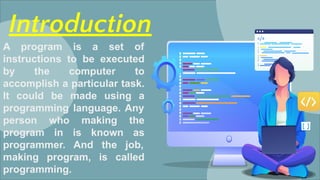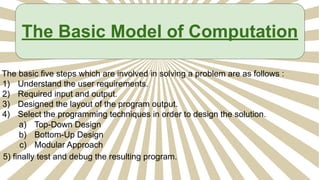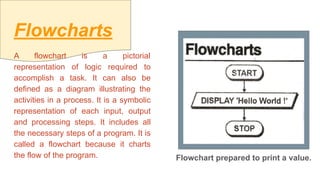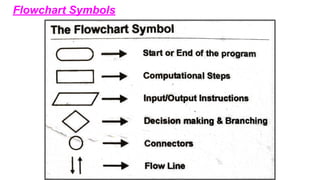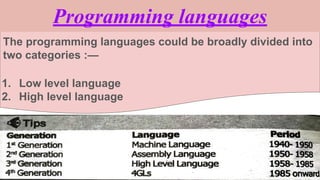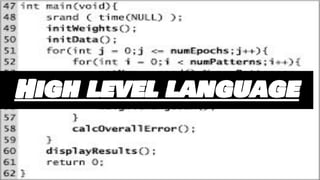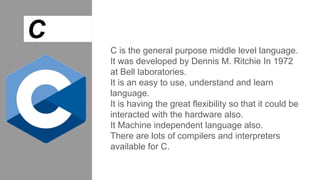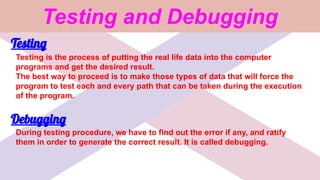Introduction to programming language (basic)
- 2. Introduction to programming topics coverage are :— Contents ❏ Introduction ❏ The basic model of computation ❏ Algorithms ❏ Pseudocode ❏ Flowcharts ❏ programming languages ❏ Compiler and interpreter ❏ Testing and debugging ❏ Documentation
- 3. Introduction A program is a set of instructions to be executed by the computer to accomplish a particular task. It could be made using a programming language. Any person who making the program in is known as programmer. And the job, making program, is called programming.
- 4. The Basic Model of Computation The basic five steps which are involved in solving a problem are as follows : 1) Understand the user requirements. 2) Required input and output. 3) Designed the layout of the program output. 4) Select the programming techniques in order to design the solution. a) Top-Down Design b) Bottom-Up Design c) Modular Approach 5) finally test and debug the resulting program.
- 5. ALGORITHMS An algorithm is a standard way of presenting the logic for solving a problem. An algorithm as an ordered sequence of well defined and effective operations that will produce the desired result.
- 6. Problem solving way in different languages.
- 7. Steps involved in performing a particular task.
- 8. Identify the step involved in preparing a cup of tea. Step 1: Boil water Step 2: Put tea powder Step 3: Pour milk Step 4: Add sugar Step 5: Mix
- 9. Steps involved for solving a problem.
- 10. Pseudocode And outline of a program written in a In a form that can easily be converted into real programming statement is pseudocode. A pseudocode consists of English statements and resembling codes. Pseudocode cannot be compiled not executed and there is no real formatting or syntax rule. Pseudocode used to print a value.
- 11. Flowcharts A flowchart is a pictorial representation of logic required to accomplish a task. It can also be defined as a diagram illustrating the activities in a process. It is a symbolic representation of each input, output and processing steps. It includes all the necessary steps of a program. It is called a flowchart because it charts the flow of the program. Flowchart prepared to print a value.
- 13. Programming languages The programming languages could be broadly divided into two categories :— 1. Low level language 2. High level language
- 15. Low level language The language which doesn't include any translator to convert its code to machine code is called low level language. Machine language and assembling language are the example of low level language. But these language are very tough to program. It is required to have the in-depth knowledge of computer hardware structure. It is also very time consuming and error prone.
- 18. High level language The high level language is designed Keeping in mind the features of portability means these languages are machine independent. The high level language is English like language code so it is easy to code and understand. The high level language require a language translator to convert the high language program into machine code. The translator which is used to do so is called compiler or interpreter. The language in these categories are :- FORTRAN, COBOL, BASIC, PASCAL, C, C++, Java etc.
- 19. C C is the general purpose middle level language. It was developed by Dennis M. Ritchie In 1972 at Bell laboratories. It is an easy to use, understand and learn language. It is having the great flexibility so that it could be interacted with the hardware also. It Machine independent language also. There are lots of compilers and interpreters available for C.
- 20. Compilers and interpreters Compiler Compiler is a program that translate source code into object code. Programs produced by compilers run much faster than the same program executed by an interpreter. Each high level programming language comes with a compiler. Interpreter An interpreter is also a compiler as it does line by line compliation. Thus, A compiler differ from an interpreter which analyze and execute each line of source code in succession without looking at the entire program. The advantage of interpreter is that they can execute a program immediately
- 21. Compiler Converts source code into object code, that is understand and executed by O/S. Each Instruction in the source code is the interpreter and passed on to the O/S, where it is executed
- 22. Testing and Debugging Testing Testing is the process of putting the real life data into the computer programs and get the desired result. The best way to proceed is to make those types of data that will force the program to test each and every path that can be taken during the execution of the program. Debugging During testing procedure, we have to find out the error if any, and ratify them in order to generate the correct result. It is called debugging.
- 24. Documentation Documentation is the complete record of program development process. It covers collecting, organizing, storing and maintaining the related information in such a way so that the end user can understand the procedure of how to operate in that program.
- 25. THANK YOU


